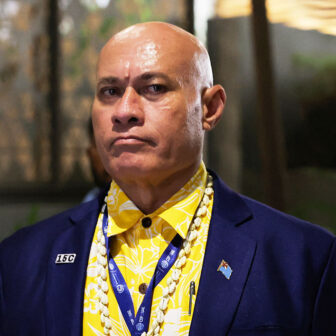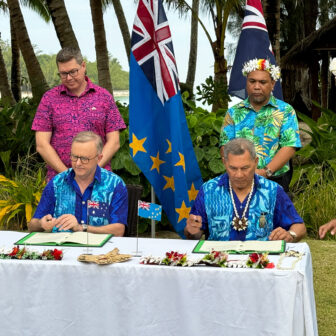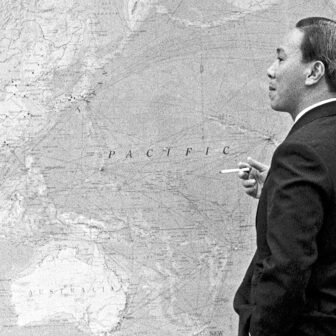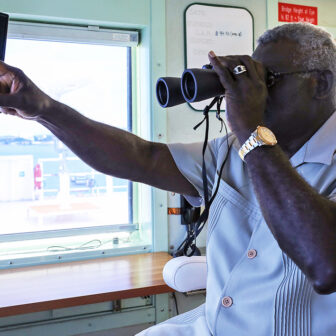Last week’s celebrations to mark the end of the Australian and New Zealand–led Regional Assistance Mission to the Solomon Islands, or RAMSI, were an occasion for much back-slapping and self-congratulation. Australian governor-general Peter Cosgrove attended the festivities in Honiara, the Solomon Islands capital, as did Pacific Islands ministers, military and police officers with Solomon Islands experience and a pantheon of former special coordinators of RAMSI.
Most participants extolled the achievements of the A$2.75 billion mission. Solomons prime minister Manasseh Sogavare, once a ferocious critic, described RAMSI as heaven sent. Jimmy “Rasta” Lusibaea, once the most notorious of the militant commanders, whose activities during the unrest of 1998-2003 first brought RAMSI to his country’s shores, thanked RAMSI for assisting the country in its “darkest hour.”“Mission accomplished,” declared former Australian prime minister John Howard in the Sydney Morning Herald, describing the fourteen-year intervention as one of his government’s “finest policy achievements.”
Despite all the acclamation, only a few could recall precisely what the mission was initially intended to accomplish, or assess how it might be judged. Australia’s first special coordinator, Nick Warner (2003–04), claimed that RAMSI had brought not only security but also prosperity for Solomon Islanders, an assessment difficult to reconcile with the notoriously squalid conditions at Honiara’s “Number Nine” Central Hospital or the country’s low per capita income (around US$2000 per annum). The Solomon Islands is undoubtedly more “stable” than during 1998–2003, but it nevertheless experienced urban riots in the capital in April 2006, November 2011 and May 2014 and saw the collapse of governments in April 2006, December 2007, and November 2011.
Warner’s successor, James Batley (2004–06), said that RAMSI had been “conceived, designed and operated as a broad and long-term state-building exercise, not simply as a security or peacekeeping operation,” and that it had “demonstrably strengthened” the police, the courts and government ministries, which were “the basic building blocks of what we think of as the modern state.” Subsequent special coordinators Tim George (2006–09), Graeme Wilson (2009–11) and Nicholas Coppel (2011–13) tended to offer a much more minimalist set of objectives, to redefine the mission as a “short-term” and narrowly “peacekeeping” one, and even on occasion to contest the “good governance” and “state-building” focus of their predecessors.
The Howard government did indeed conceive and design RAMSI as entailing a long-term radical transformation of the Solomon Islands state, but even before this had commenced it had provoked a major political crisis. It was in response to that crisis that Australian police activities were toned down, strategic ambitions were tempered, and operations were constrained around the narrower framing of RAMSI’s objectives.
RAMSI’s special coordinators had a high local profile in Solomon Islands, but their role was primarily an oversight one, and their activities centred on public relations, the media and the civilian programs. The core military and policing components of RAMSI were under separate command, at times triggering some friction. Special coordinators were ultimately answerable to the Australian foreign minister and through “whole of government” accountability mechanisms established back in Canberra.
Although RAMSI occurred under the auspices of the Pacific Islands Forum, Island leaders played little or no role in the Canberra-centred command and control. Their participation was restricted to occasional expert missions, and more regular in-theatre consultation exercises. They also supplied troops and police personnel, and Pacific Islanders played an important but often unacknowledged role in the civilian ministries.
RAMSI commenced in 2003 in the wake of five years of civil unrest, which had resulted in around 200 fatalities. The high point of the disturbances (locally known as “the tensions”) was 1999–2000, culminating in the coup of 5 June 2000. After a flawed peace agreement in October of that year, the conflict morphed into a criminalised extortion racket perpetrated by militia groups who refused to surrender their weapons.
When RAMSI arrived in July 2003, as a first mission under the auspices of the Pacific Islands Forum’s 2000 Biketawa Declaration, its big achievements were on the security front, and they came quickly. Guns were surrendered and destroyed, and militant leaders incarcerated. This was accomplished almost entirely by Australian military and police officers organised in an institutionally separate Participating Police Force. The Royal Solomon Islands Police Force, or RSIP – described by senior Australian Federal Police officers as too corrupt to participate in RAMSI’s operations – was shunted aside. Policing accounted for the vast majority of RAMSI personnel and it swallowed the bulk of RAMSI expenditure, although most of this was sent home as expatriate salaries.
The courts, too, were soon staffed by expatriate judges and legal professionals, as was the Ministry of Justice. Once the tension trials were completed around 2009, the foreigners went home, leaving an understaffed and underqualified legal administration.
The ramifications of the “two forces” policing model became painfully apparent around 2009–10, when several reports highlighted the continuing poor state of the RSIP. Severe demoralisation among the senior officers pre-dated the RAMSI years, and reflected the RSIP’s failure to tackle the tensions without outside assistance. In June 2000, the RSIP’s paramilitary arm, the Police Field Force had orchestrated a coup in conjunction with the militia group, the Malaita Eagle Forces. Many senior officers had collaborated with the militants thereafter.
That humiliation was reinforced after RAMSI’s arrival, when RSIP officers watched as their better equipped, better-trained and much better paid Australian and New Zealand counterparts restore security. Surveys indicated that the general public held the RSIP in low esteem, while RAMSI’s policing efforts had a stellar reputation. Around two-thirds of the RSIP were retired, arrested, dismissed or otherwise decommissioned over the initial RAMSI decade, and around 70 new police officers were recruited per annum. The result was a youthful and inexperienced police force, with a weak leadership, but the payoffs of this work may well be generational. It is the success or failure of this police-building project that will ultimately be critical for the longer-term evaluation of RAMSI, not the limited governance programs brokered in the other ministries.
Outside policing, prisons and the justice ministry, RAMSI’s activities were mostly piecemeal. Programs in the Ministry of Finance mainly entailed new software systems that were never likely to endure over the longer-term without ongoing foreign oversight. Tax collections rocketed under the influence of officials from New Zealand, but RAMSI never gained control over government expenditure, much to the displeasure of the “shared sovereignty” enthusiasts in the donor community. Sensible programs were pursued in the auditor-general’s office, in parliamentary support services and, episodically, in the elections office, but most of the country’s twenty-four ministries continued as before, with little or no RAMSI engagement. Other major donor-driven achievements include halting the spread of malaria, at least in the easier eastern part of the scattered country, although this was the fruit of sensible bilateral programs rather than RAMSI.
RAMSI is best seen as a three-phase mission, interrupted by a major political crisis. In the initial phase, John Howard’s government – and particularly the abrasive foreign minister Alexander Downer – insisted on economic liberalisation and “good governance” as the price for security assistance. Downer once thumped his fists on the Solomon Islands’ cabinet table, insisting that politicians do his bidding and that RAMSI was an “all or nothing” take-it-or-leave it package. This was the declared state-building project aimed at reconstructing the country from the top downwards. Yet, unlike contemporary UN missions to East Timor and Kosovo, RAMSI never had formal executive authority to achieve its objectives but was reliant on collegial persuasion or cash conditionality. Solomon Islands politicians wanted help to subdue the militant groups, but most were less keen on external advisers’ activities in the ministries, particularly finance.
Downer and his colleagues tended to describe all resistance as driven by corrupt politicians or businessmen. In some cases it undoubtedly was, but not in all. Behind the scenes, even close allies of RAMSI, whose images appeared in the glossy anniversary pamphlets celebrating the mission’s success, would contest the mission’s intrusiveness, or its ignorance of local custom, and warm to local leaders offering a project of national re-assertion. Conversely, many of the most notorious local backers of RAMSI were themselves unscrupulous businessmen known for their intrigues in search of casino licenses, or for using logging cash to broker favourable Melanesian governing coalitions. The prime minister who initially invited RAMSI to Solomon Islands, Allen Kemakeza, had himself been sacked for corruption in 2001, and he was also imprisoned – albeit long after RAMSI’s arrival – for his role in orchestrating a militant attack on a local law firm during the tensions.
Sir Allen was prime minister during the early years when RAMSI’s authority was at its zenith. Yet he fared poorly at the first post-RAMSI election in April 2006. With backing from local Chinese businessman Tommy Chan, the country’s 50 MPs selected Snyder Rini – Kemakeza’s former deputy, who had a poor record on corruption issues – as new prime minister. Rini was also opposed by the Australian government, as evidenced by a leaked email recording Australian high commissioner Patrick Cole’s behind-the-scenes efforts to avert that outcome.
Rini’s election sparked riots outside parliament, culminating in the destruction of Honiara’s Chinatown district. He lasted only eight days before resigning to avoid an impending no-confidence defeat. His successor, Manasseh Sogavare, had been prime minister at the height of the tensions (2000–01), and his second term (2006–07) saw Cole expelled. The country’s Australian police chief, Shane Castles, was also declared persona non grata for unwisely authorising a raid on the prime minister’s office to search for evidence of illegal activity.
If RAMSI had been unpopular, Sogavare would surely have succeeded in ending the mission. (Parliament was entitled to terminate RAMSI with three months’ notice.) Instead, it was Sogavare who was terminated, ousted by his own parliament in a no-confidence vote in December 2007. A month earlier, John Howard’s government lost the Australian election, and was replaced by Kevin Rudd’s Labor administration.
The second phase of the RAMSI operation, sparked by the failure of the Howard–Downer strategy, entailed a major change in the mission’s dynamics. Just as Sogavare had been unable to rally support for the expulsion of RAMSI, so too had Downer’s “all or nothing” bluff been called. The new prime minister, Derek Sikua, was much more favourably disposed towards RAMSI than his predecessor, but many of Sogavare’s ministers survived in cabinet. Sikua appealed to RAMSI for more funds, particularly for rural development and for education, but Australian officials were wary of the danger of mission creep. Rudd’s government wanted to roll out “partnerships” across the Pacific, and to focus on the millennium development goals, but most of the assistance to health and (largely from New Zealand) to education was organised on a bilateral basis rather than through RAMSI.
Unsurprisingly, Solomon Islanders barely noticed the difference. RAMSI’s second phase was much more cautious than the first: it was already oriented towards an exit strategy. The mantra was that RAMSI’s departure would be determined by the completion of tasks rather than by some arbitrary deadline. Since RAMSI’s departure was now firmly on the horizon, its critics felt less threatened and, accordingly, became less vociferous.
The last phase of RAMSI commenced in 2013, when RAMSI was disassembled and its military contingent departed. All civilian programs were disbursed to multilateral or bilateral agencies, mostly to the Australian and New Zealand high commissions. The claim that the mission would end only when its tasks were completed vanished without trace. All that continued under the RAMSI auspices was a slimmed-down police assistance program. In itself, this was an acknowledgement of unfinished business. So, too, was the continuing appointment of Australian police commissioners, and the announcement of a post-RAMSI bilateral police assistance program.
The main change in mid 2017 is therefore the removal of the Pacific Islands Forum’s jurisdiction. Former critics, including three-time prime minister Sogavare, now feel able to embrace what was left of RAMSI, which is, after all, confined to the police-assistance program that Solomon Islands politicians always preferred.
Intervention missions are never easy to judge. Is the appropriate yardstick subsequent stability or achievement of democracy? Should success be assessed relative to declared objectives or some wider standard? Australia’s initial expectations were undoubtedly ambitious, but these were resisted by Solomon Islands politicians who retained both office and legal authority.
In the first phase, the priority was the arrest of the militants and the confiscation of their weapons. Before the intended second state-building phase got under way, the Sogavare crisis intervened, triggering a major re-orientation. Solomon Islander politicians did not share the Australian government’s enthusiasm for building their state, but both sides agreed on the immediate objectives of removing guns from communities, the peacekeeping operation, and the need to transform the RSIP. The major longer-term focus of RAMSI was thus on policing, and it is success or failure in this respect that will ultimately settle the debate about RAMSI’s legacy. •




